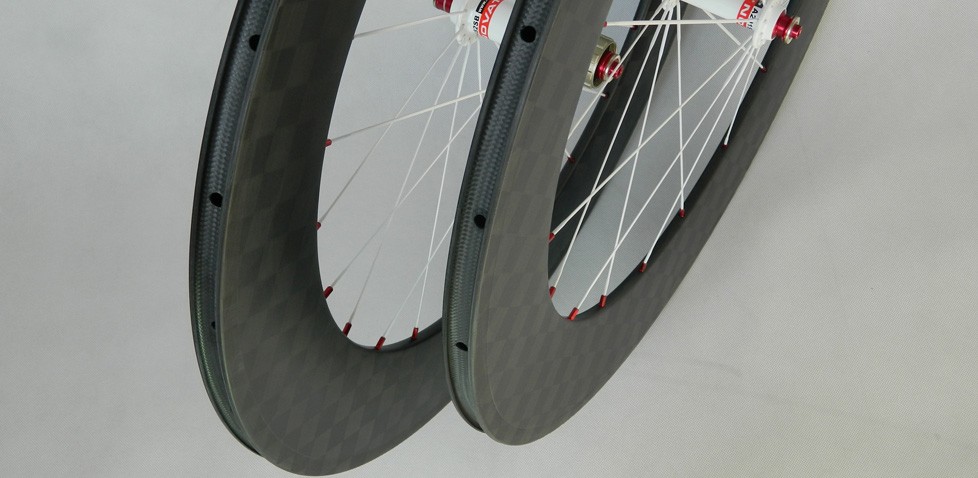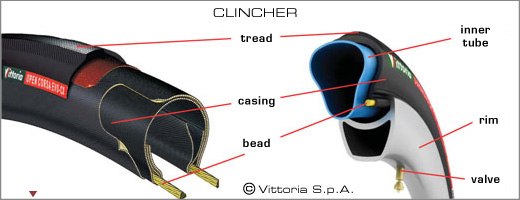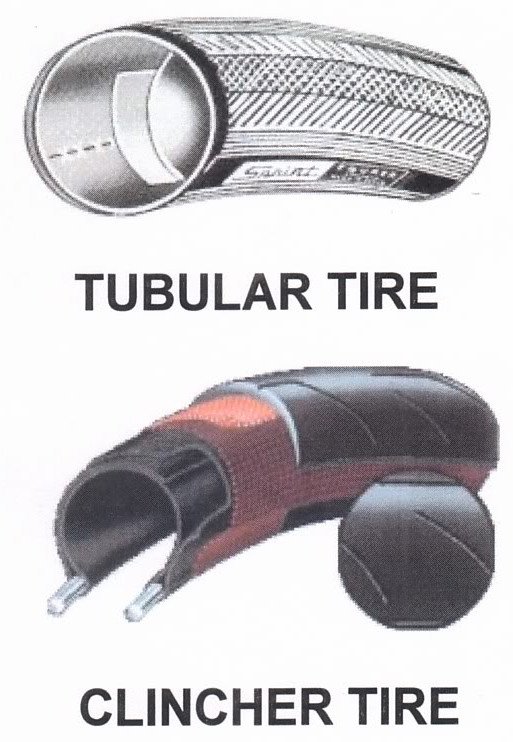- You are here:
- Home »
- Blog »
- Blog
- » What Does Clincher Mean?

What Does Clincher Mean?
If you have ever been to a bicycle store or have had any friend who is a biking enthusiast, you must have heard the word clincher at some point.
What does clincher mean?
It is a kind of bicycle wheel. This kind of wheel clinches the tire with a ridge on the inside running along the tire. Beads made from strong materials snugly seal against the ridges. This way it can stay in place when the tire is mounted on the rim.
Construction of a Clincher
The construction is similar to other types (e.g. tubular) in some ways.

Image source: ikoncykler.dk
- Casing:
The casing is usually made of cloth of nylon or cotton. It provides necessary resistance and barrier for internal air pressure. The casing can affect the weight of the tire and therefore its performance. Casings with high thread counts have better quality. The casing ends in wrapping the two beads.
- Bead:
This is the material at the edge of the tire that is attached to the rim. It is made from strong material that stretches very little so that it sticks tight to the rim and maintains internal air pressure.
Beads are of two kinds. The first is a wire which is most commonly found in clincher tires. These cannot be folded. The second is Kevlar, which is foldable and more expensive than wire.
- Tread:
This is the part of the outer layer of the tire that comes in contact with the road. The compound used for making treads is butyl rubber. Some additives are also found in some treads like carbon or silicon. These provide traction and reduce rolling resistance. The pattern ranges from smooth to knobby.
- Tube:
This is the most commonly known part of many tires and perhaps very important as well. It is made of butyl rubber or latex. It is easily repaired and replaceable.
Difference Between Tubular and Clincher
The two styles of tires have a significant difference when it comes to design. Tubular tires are also called sew up. The casing and the inner tube are sewn together, hence the name. They are then connected to the rim with glue. Clinchers, on the other hand, are open at the bottom, and the metal beads at the bottom connect to the clincher part of the rim and sit tight on the rim. This is the basic difference between these two tires.
But it is better to compare the two in different areas as both of these tires have their benefits. Most bicyclers prefer clincher, especially for training purposes. At the end of the day, it is your needs that will determine your decision about which tire to get. And for that you need to know which tire excels where:
-
Puncture Resistance

Image source: bikeforums.net
Tubular tires have more pressure as compared with clincher tires so they can be more sturdy and resistant to punctures. But clincher tires do not lag behind in this scenario. The flat protection technology which is found in many brands helps protect the tire from flats.
-
Rolling Resistance
Rolling resistance depends on several factors like the rubber of the tire, the sturdiness of the casing, the air pressure, the weight of the cyclist and the roughness of the road. Both clincher and tubular tires have been found to have low rolling resistance. Generally speaking, tires with soft casings and latex tubes tend to have lowest rolling resistance. Tubular tires are more prone to high rolling resistance on account of their adhesion to the rim. If the gluing is poor, the tire may move or shift. Hence, clinchers have better-rolling resistance as compared with tubular.
-
Weight
Since there is no beading required in tubular tires, they tend to be lighter than clinchers. Clincher tires can weigh some hundred grams. Low rotational mass can prove helpful in irregular or hilly roads. Tubular hold a bit more advantage here over clincher.
-
Aerodynamics
The aerodynamics of these tires is related to the width of the tire and smoothness of transition of the tire to the rim. Clincher takes the cake in this regard as they have the higher smoothness of transition mainly because there is no interference like that of the tubular tape in tubular tires. Do not go for the too narrow tire as it will affect the aerodynamics.
-
Ease of Repair
Many people assume that clinchers are easier to install, but both tubular and clincher have their advantages in this regard. Some clincher tires can be hard as it easy to damage the levers or the tube when changing. Now, both the tires are easily installed. The tubular tape helps make installation of tubular fast. You can easily cut the bias of the tire with a razor blade and remove a tubular in an emergency. Carbon clinchers have been known to install quickly.
-
Rubber Compounds
This depends more on the brand than the type of tire. Many rubber compounds are found in both tubular and clincher. Clincher tires have the lower average pressure of air and hence usually have softer rubber compounds. Some companies use the same kind of rubber and construction methods for both the tires, so there is not the much significant difference between the two in this category.
-
Durability
Since the technology and construction are usually the same for both tires in many brands, the durability tends to be the same as well. It depends on upon the brand you are choosing than the type. That said, clinchers have an unquestioned advantage over tubular that you can just remove a small nail and start riding again. They are more resistant that way because tubular casing can be more difficult to repair even if it is affected by a small nail. So regarding reusability too, clinchers seem to be a better option.
-
Quality
There was a time when tubular offered the best quality of ride and best quality overall but with latest advancements clincher is not far behind. Latex tubes and soft casings have allowed clincher tires to give the same quality as that of tubular tires. The latest tubeless clinchers have been known to have high quality and many brands are offering these now. Vittoria, Valoflex, and Zipp are some popular brands known for high-quality clincher tires.
-
Cost
Clinchers are cheaper than tubular. Even though you will find some clincher and tubular, perhaps from the same brand, to be the same price but clinchers are less expensive. And therefore, make a good choice for training purposes.
Pros and Cons of Clincher vs. Tubular
Clincher
Here are some pros and cons of clincher tires:
Pros
- They are cheap
- They are easy to install and maintain
- Rolling resistance is low
- Fixing a flat is easy
- You only need an extra tube instead of a tire
- Better aerodynamics
Cons
- They are heavier than tubular
- More prone to pinch flatting
Tubular
Here are some pros and cons of tubular tires:
Pros
- They are light weighted
- There is lesser chance of pinch flat
- They can even ride flat for some distance
Cons
- Not easy to install or repair
- They are more expensive
- They can’t move if not glued properly
- Flats may result in the loss of the tire as it is difficult to repair
How to fix a flat clincher tire?
Now you know that fixing a flat clincher tire is easy as compared with tubular. But still it will not be that easy. You must follow the proper steps to ensure that your flat tire is fixed quickly and properly. There are different kinds of flats as well. Mostly you get a flat tire because of sharp objects like a nail or glass sticks to the tire. This is more common on wet days when they stick easily to the tire. Pinch or snakebite flat is when the tube is ripped in two places. This can be avoided by keeping the tires fully inflated.
Here are some necessary tools you should keep in your kit for fixing flats:
- Tire levers
- Patches
- Rubber Cement
- Sandpaper
- Spare tube
- Pump
- 15 mm or Adjustable Wrench
Here is how you can fix a flat clincher tire:
- First, you need to pry the tire from the rim using a tire lever. One bead should be within the rim so that the tube and the wheel are aligned. Avoid using a screwdriver or a knife to do this job as it can put scratches on the rim.
- Now pull the tube out of the tire, beginning from the opposite valve. Do not hurry in this step because you would want to find the affected position of the tube and the thing that caused the puncture. In case you are replacing the tube, the next two steps can be avoided. Make sure you find the sharp object and remove it because otherwise you might get another flat.
- Now that the tube is out inflate it a little using a pump. Look for the puncture. You can easily hear the sound of the escaping air from the puncture and check with your hand to see the spot. You can even keep the tire near to your ear and check for the sound. If you do not succeed, then resort to the conventional water basin method. Submerge the tube in a water basin and look for bubbles. That is the spot punctured.
- Use a buffer to scrape the area around the puncture. This helps in cleaning as well as roughening it to provide ample friction to hold the patch. You can cover this area now with the adequate amount of rubber cement. Cover it around the affected area. Now wait for five to ten minutes to let it dry completely.
- You can use this time to find the object which caused the puncture. If you know how the tube was aligned up you will be able to find the object where the punctured area of the tube was within the tire. A better trick is to take a small piece of cloth and run it along the tire so that object sticks to the cloth.
- Once the cement has dried, remove the silver foil from the patch and apply it on the tire. You must rub it roughly from the center of the patch towards outside so as to make it stick well. You can leave the cellophane on to provide more protection.
- Now inflate the tube, only slightly and put it back into the tire. Squeeze the bead and put it back on the rim. Now inflate it more and ensure that the bead sits on the rim snuggly. If it is not sitting properly, there is a chance that it may slip out and the tube will be squeezed against the rim and burst. In such a case it will not be fixable.
- Finally, put the wheel back on your bicycle. When the wheel has been placed, inflate the tire. Make sure the pressure is same as the other tire. Avoid using air pumps at gas stations as they are suitable for large tires of four-wheeled It can burst your tire. Before finishing, tighten the bolts using your wrench.
Conclusion
Now the next time someone asks you what does clincher mean, you have a lot of information to share with them. Clincher is a type of bicycle tire that uses two beads to attach to the rim and uses a tube. Clincher tires are less expensive and easily repaired and installed as compared with their rival tubular tires.
When it comes to clincher vs. tubular, there are many differences besides design. What makes clincher better than tubular is its low rolling resistance, low pricing, and high reusability. Whether you are a professional cyclist or just someone who likes riding sometimes, clinchers can make your life very easy. There is nothing worse than a flat tire during a race. However, with clinchers, you cannot ride with a flat tire, and they are heavy. Nevertheless, the many qualities it offers to give it enough leverage over other tires.
About the Author Nick Soros
Hi, I'm Nick Soros. I have been an cycling enthusiast from 2006. Ezroadbike.com is my personal blog where I share my pedaling experience. No matter you are a new cyclist or skillful one, you would find useful topics in my site. Have a great cycling...
